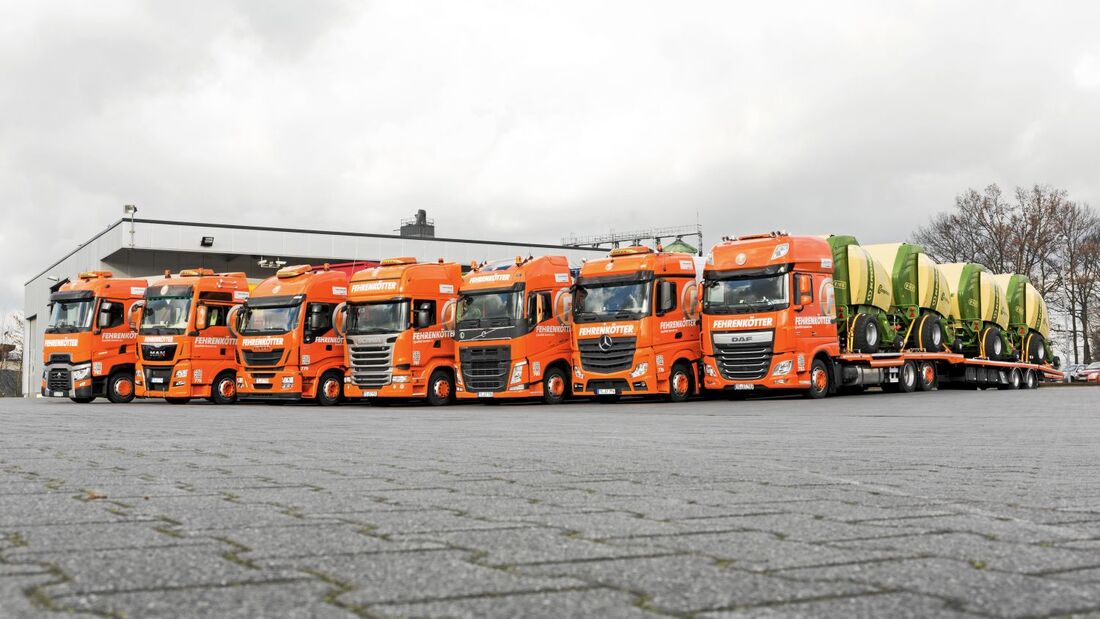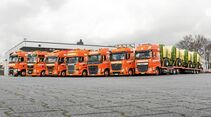From loser to leader – the development of the Volvo FH has been surprisingly positive in the last 11 months. The vehicle arrived for the start of the test with rust film on the frame, and after a few days the retaining straps of the exhaust system then tore. The Swedish truck did not get off to a good start in the test, immediately reporting a day lost on its cost account at 1,000 euro. Combined with a purchase price in the mid-range of its competitors, a top place was initially hardly to be expected among the seven trucks taking part in the trans aktuell Fehrenkötter test.
Volvo with the surprisingly lowest diesel consumption
But the first projected results already surprisingly revealed Volvo had the lowest diesel consumption in the field, reaching second place behind the Mercedes Actros. Up until then, the Actros had got by without having to go to a repair shop, thus staying ahead of its six rivals – until November 20 of last year. Fehrenkötter then had to have new batteries installed for the Actros, reporting two hours of time lost. Further workshop visits in December and at the start of February followed. All in all, the Actros was not available for transport use for 1.5 days. This cost the freight forwarder Fehrenkötter 1,500 euro, which is clearly reflected in the TCO ranking.
According to the latest calculation, the Actros is behind the Volvo FH, which has the top ranking, reaching a humble fourth place behind Iveco and DAF. However, the truck made in Wörth still has the second best diesel consumption at 30.83 l/100 km and the most economical AdBlue consumption.
Why are Iveco and DAF ahead of Mercedes with the Actros' consumption being so good? Both trucks have a half a day lost less on their accounts and were considerably cheaper to purchase. Both points together give the imported vehicles an advantage on the cost side, which cannot be made up for with the variable costs within a year.
In addition, the DAF XF gained ground by having one day lost less in the evaluation than it initially had in the first calculation. After an extensive review of a case of damage of June 2014, the freight forwarder and DEKRA, the German safety inspection company, ascertained that the XF had to go to a workshop due to a design flaw on the part of the body manufacturer. Therefore, the costs and time expenditure are not to be allocated to DAF.
Compared to the last trans aktuell Fehrenkötter test, the Iveco truck exceeds all the expectations the freight forwarder Fehrenkötter had of it. "We hardly have problems with the vehicle," fleet manager Robert Theis says. Overall, a few smaller repairs added up to one day lost, which is of less consequence for the cheapest vehicle than for the other rivals. Also when it comes to diesel consumption, the Italian vehicle shows no weakness. It comes fourth in consumption at 32.08 l/100 km, reducing average consumption by 0.07 l since the last calculation despite the onset of winter.
Looking at the figures for consumption differences once again shows the Volvo in a positive light. The Swedish vehicle has improved by around eight tenths, making the FH the only truck under the 30-liter mark. The Renault Trucks T, its counterpart in the same Group, marks the other end of the scale. With average consumption at 33.22 l and an increase in about 1 liter, the French vehicle has become a gas-guzzler.
High maintenance costs
"Half a liter of additional consumption is normal in the winter," fleet manager Theis says with regard to the freight forwarder's Mercedes fleet. He explains that this is also due to engine running times when stationary. In the winter, drivers sometimes have to run the truck for half an hour in the night so that the preheating system holds out until the next morning. "If I don't start the engine in between, the battery management system simply turns off the preheating," Rolf Girndt explains his daily routine in the Renault T. The preheating system's automatic shutdown means the vehicle starts up in the mornings, but leaves the driver frozen stiff. "All our vehicles have problems with the batteries," Theis adds. "We replace the batteries every two years irrespective of the condition."
That also applies to the trucks from the two subsidiaries of the VW Group. At present, the MAN and Scania vehicles are in fifth and seventh places. What distinguishes both for the same reason is the relatively high maintenance costs. Thus, MAN and Scania have run up costs of 1,376.04 euro and 1,303.55 euro, respectively. By comparison: The service costs for the DAF currently come to 632.44 euro.
The Scania is not just one of the most expensive vehicles in the field when it comes to service. Up until now, the Swedish vehicle has also had by far the most workshop visits. Driver Frank Engelmann keeps complaining about an increased oil consumption. Engelmann has so far refilled about 75 liters of lubricant. In addition, the Scania has spent about three days so far in the workshop. All the additional expenses together with the highest purchase price keep the Scania R450 in last place. At least, Scania gave an oral assurance to the freight forwarder Fehrenkötter that it would give it an extended drivetrain warranty of five years on account of the high oil consumption.
And who knows, perhaps the Scania will improve from now on and still reach a top position by the end of the period just like its Swedish counterpart Volvo.
Column – "Driver's cab 2.0"
Joachim Fehrenkötter, CEO: "Our test is often about the hard facts such as consumption, time lost or total costs. But apart from the technical side of things, there is one key determining factor for the efficient use of trucks, i.e. a motivated driver. Commercial vehicle manufacturers have done a lot in this respect to take the burden off the person behind the wheel and enhance their driving pleasure again. The significantly enlarged cabs feature such amenities as independent air conditioning systems and interior technology that can be operated from the bed. This all serves to take the burden off the driver in a more than demanding job. At this juncture, manufacturers should not just lie back and relax. It is getting more and more difficult every day to find good, motivated truck drivers. It also makes sense economically – besides showing appreciation for staff – to gear the vehicles even more to drivers' needs. It is about providing safety in the form of driver assistance systems on the one hand, and improved comfort in the form of new driver's cab concepts on the other. In my view, some manufacturers have already chosen the right approach. Precisely in long-haul traffic, it is very appreciated if there is a differently designed seat next to the driver's seat as a more or less furnished living area. Truck drivers regard it as very relaxing to separate the working and living areas. In this area, a lot more will be seen in the coming years, which I personally believe will involve trucks for regional and local transport. In addition, our drivers also view active safety systems as useful support on often monotonous routes. I am happy that the commercial vehicle industry is moving in the right direction with regard to these soft (comfort) and hard (safety) criteria, building vehicles which make the job of truck drivers a lot easier."









